Building powerful, repeatable systems is the core of modern operations. Yet, the tools meant to create these systems often become the bottleneck, trapping builders in rigid interfaces that stifle creativity. The best Zapier alternatives move beyond simple triggers and actions, offering a more intuitive way to translate intent into automated workflows. In fact, teams using next-generation automation tools report an average 30% reduction in development time for new processes (Gartner, 2024), freeing them up for higher-value work. This guide explores 12 platforms that empower you to build faster and smarter.
You know the feeling — wrestling with a visual builder, trying to force a complex business process into a series of predefined boxes. The initial promise of ‘no-code’ freedom gives way to frustrating limitations and rising costs as your needs grow more sophisticated.
By shifting your perspective from clicking nodes to expressing intent, you can cut your automation build times by up to 80% and connect systems in ways you previously thought required a dedicated engineer. The solution isn't just finding a cheaper or faster Zapier clone; it's about adopting a new building paradigm altogether. For those looking to integrate these powerful solutions, this practical guide on how to automate business processes can offer foundational insights.
Unlike generic AI automation posts, this guide will show you real CodeWords workflows — not just theory. We will examine each platform with detailed profiles and direct links to help you choose the right automation partner for your specific needs, from marketing to operations.
TL;DR
Why look for a Zapier alternative?
Zapier pioneered no-code automation, but the landscape has evolved significantly. While it remains a popular choice for simple point-to-point connections, its linear, task-based model can become a constraint for experienced operators building more sophisticated systems. The primary drivers for seeking Zapier alternatives today are the need for greater flexibility, more transparent pricing for high-volume tasks, and deeper integration with AI capabilities. Many modern platforms offer visual canvases for complex logic, developer-friendly features for custom code, or AI-native interfaces that bypass visual building entirely.
What should you look for in automation software?
Choosing the right automation platform requires looking beyond the number of app integrations. The ideal tool aligns with your team's technical skill set, the complexity of your processes, and your budget. Key factors include the user interface — whether it's a visual canvas, a linear builder, or a conversational AI. You must also consider the pricing model, as task-based pricing can become expensive at scale compared to execution-based or usage-based alternatives. Finally, evaluate the platform's support for custom logic, error handling, and developer tools, as these features determine its ability to grow with your business needs.
Which are the best Zapier alternatives in 2025?
Here’s a breakdown of the top platforms that offer compelling advantages over the traditional automation model.
1. CodeWords
CodeWords represents a fundamental shift in workflow automation, moving beyond the traditional drag-and-drop interface. Instead of visually connecting application nodes, users describe their desired outcome to Cody, an AI assistant. This chat-native approach transforms a complex technical task into a simple conversation, drastically reducing the time from idea to a fully deployed automation.

The platform’s core strength is its one-prompt building process. You can instruct Cody to, for example, "monitor my Gmail for invoices, extract the total amount and due date, and add a new row in my Google Sheet," and it will generate, configure, and test the necessary code. It handles the technical busywork of debugging and deployment, enabling non-technical founders and operations managers to build powerful, custom automations not limited by predefined triggers and actions. This unlocks a level of flexibility previously reserved for developers. Exploring different AI workflow automation tools and their applications can provide more context.
Pros:
- One-Prompt Creation: Build workflows by describing them in plain English.
- 2,700+ Integrations: Extensive connectivity across marketing, sales, and ops tools.
- Automatic Debugging: The AI handles technical troubleshooting.
- Community Resources: Strong support through templates and clear documentation.
Cons:
- Variable Pricing: Usage-based costs can be unpredictable for large-scale deployments.
- Limited Public Compliance Info: Enterprise buyers will need to conduct their own security diligence.
Website: https://codewords.ai
2. Make (formerly Integromat)
Make stands out as a powerful visual automation platform for users who require complex, multi-step workflows. Its drag-and-drop canvas allows you to build sophisticated scenarios with branching logic, filters, and error handlers, giving you granular control over how your data moves between applications. This visual approach makes it easier to conceptualize and debug intricate automations that would be cumbersome to build in a linear interface.
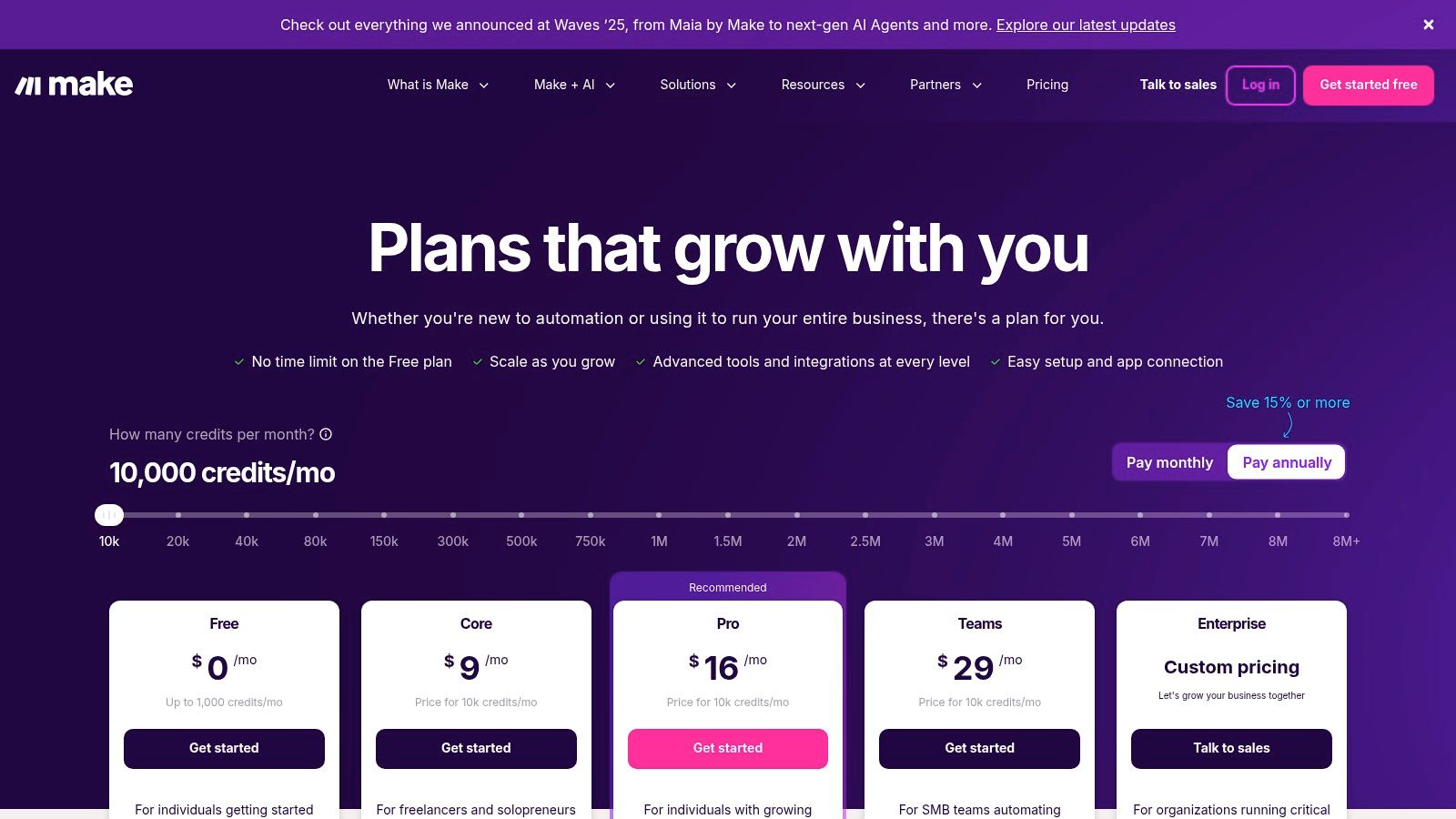
Make operates on a credits-based pricing model, where each action or "operation" consumes a credit. This can be cost-effective for users running a high volume of tasks. The platform supports over 3,000 app integrations and offers robust support for custom APIs. While its visual builder has a steeper learning curve for advanced logic, the free plan is generous enough for simple, personal automations.
Key Details & Pricing
- Best For: Operations and product managers, data analysts, and anyone needing to build complex, multi-path automations.
- Pricing: Offers a free plan with 1,000 operations/month. Paid plans start at $9 per month (billed annually).
Visit Make
3. n8n
n8n is an open-source, extensible workflow automation platform that serves as a powerful Zapier alternative for technical users and teams prioritizing control. It can be self-hosted for complete data sovereignty or used via its hosted cloud service. This flexibility makes it a top choice for developers and organizations with strict data governance policies. The platform's developer-centric features, such as versioning and code nodes, allow for deep customization beyond typical no-code interfaces.
The platform supports hundreds of integrations and allows for unlimited steps within a single workflow. Its hosted pricing is based on workflow executions rather than tasks, offering a transparent and predictable cost structure. While self-hosting offers ultimate control, it does require DevOps knowledge to set up and maintain.
Key Details & Pricing
- Best For: Developers, technical teams, and businesses that require self-hosting options for data privacy and full control.
- Pricing: Offers a free Community Edition for self-hosting. Paid cloud plans start based on workflow executions.
4. IFTTT
IFTTT, which stands for "If This, Then That," serves as an excellent Zapier alternative for users focused on simple, direct automations and smart home integrations. The platform operates on the concept of "Applets," which are pre-built connections that link a trigger in one service to a single action in another. This straightforward model makes it incredibly accessible for beginners. Its strength lies in its vast library of consumer-facing services and IoT devices.
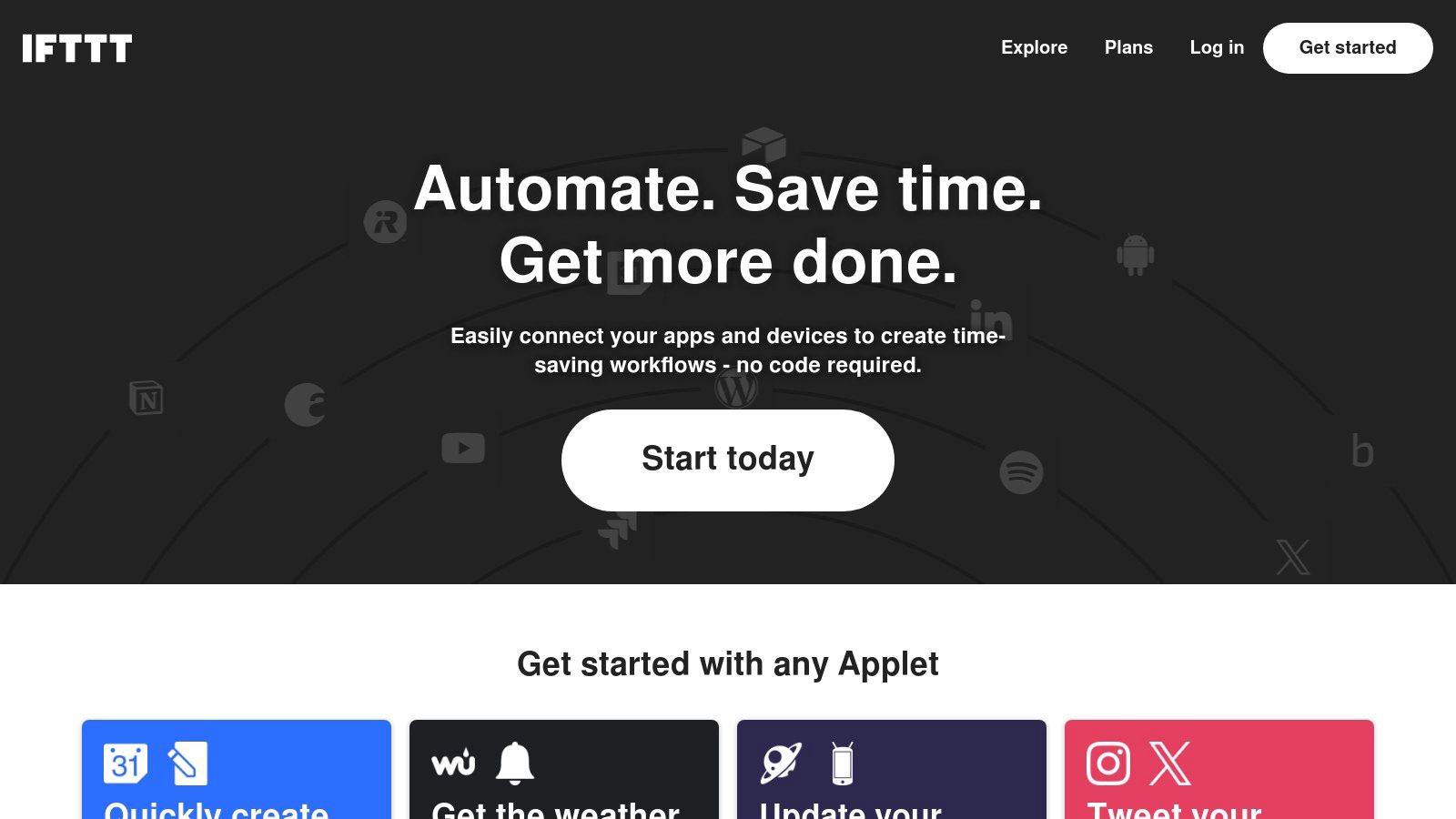
While the free plan is limited, IFTTT’s Pro and Pro+ tiers unlock more powerful capabilities, such as multi-action Applets and conditional logic. The platform shines with its extensive library of community-created Applets, which allows for instant setup without any building required. However, for intricate business workflows, users might find its capabilities restrictive.
Key Details & Pricing
- Best For: Individuals, smart home enthusiasts, and small business owners needing simple one-trigger/one-action automations.
- Pricing: Offers a free plan for 2 Applets. Paid plans with more features start at $2.50 per month (billed annually).
5. Microsoft Power Automate
For organizations deeply embedded in the Microsoft ecosystem, Microsoft Power Automate presents a compelling alternative. It excels at connecting data across Microsoft 365, Dynamics 365, SharePoint, and Teams. Its capabilities extend beyond cloud-based workflows, offering robust Robotic Process Automation (RPA) for automating tasks on desktop applications, a feature that addresses enterprise-level needs for legacy system integration.
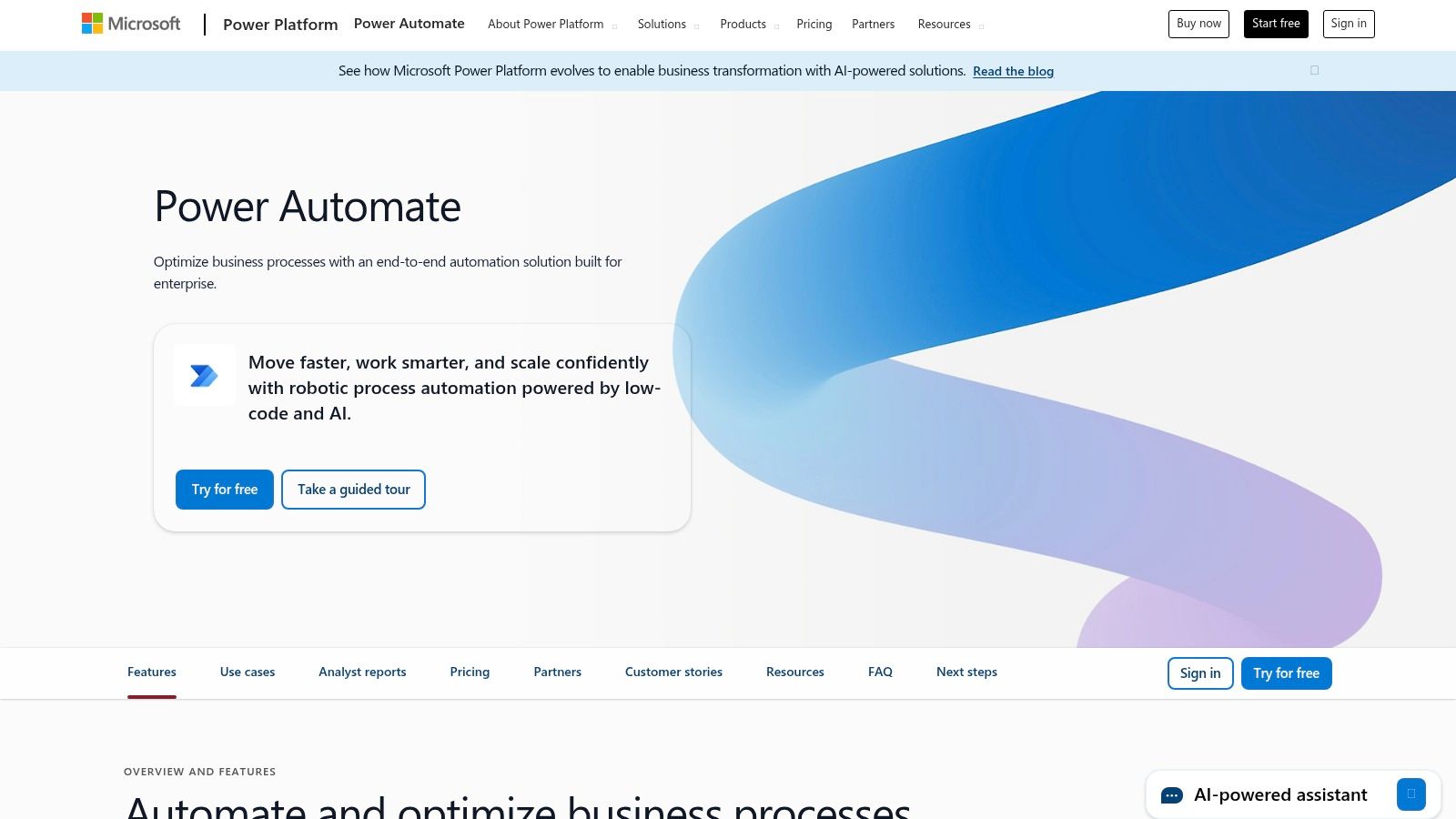
Power Automate is built with enterprise governance in mind, offering centralized administration and seamless integration with Microsoft Entra ID. This ensures IT departments can maintain security and control. While its deep integration is a major strength, the licensing model can be intricate, with costs varying based on user types and the need for premium connectors.
Key Details & Pricing
- Best For: Enterprises using the Microsoft 365 and Azure stack and teams automating legacy desktop applications with RPA.
- Pricing: Offers limited free use with Microsoft 365 licenses. Standalone paid plans start at $15 per user/month.
Visit Microsoft Power Automate
6. Pipedream
Pipedream is a developer-centric integration platform that blends a no-code UI with the ability to execute serverless JavaScript and Python code. This hybrid approach makes it a compelling option for technical users and engineers who need to move beyond simple triggers and actions into complex API manipulations. It empowers users to prototype and deploy event-driven workflows rapidly with fine-grained control.
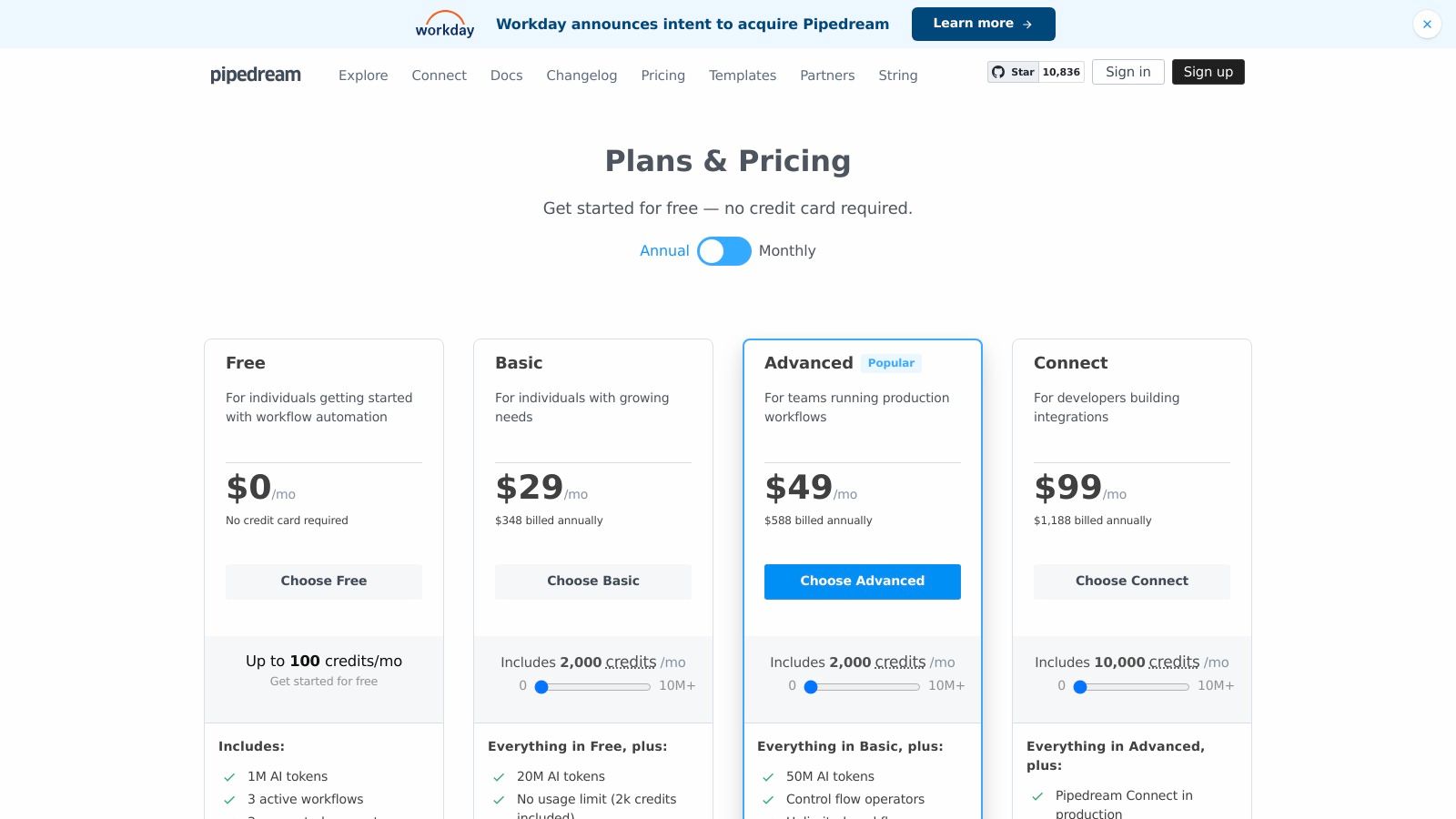
The platform is designed for an API-first world, offering unlimited workflow testing and GitHub Sync for version control. While the terminology around credits and compute time can initially be confusing for non-technical users, Pipedream’s free tier is exceptionally powerful for individual developers and small projects.
Key Details & Pricing
- Best For: Developers and technical product managers who need to automate API-heavy processes and write custom code.
- Pricing: Offers a free tier with unlimited workflows and connected accounts. Paid plans start at $29 per month.
7. Workato
Workato positions itself as an enterprise-grade iPaaS (Integration Platform as a Service) for mid-market and enterprise organizations. It is engineered for complex, mission-critical automations that require advanced governance, security, and lifecycle management. The platform goes beyond simple trigger-action workflows, enabling users to orchestrate processes across the entire organization with a library of pre-built automation "recipes."
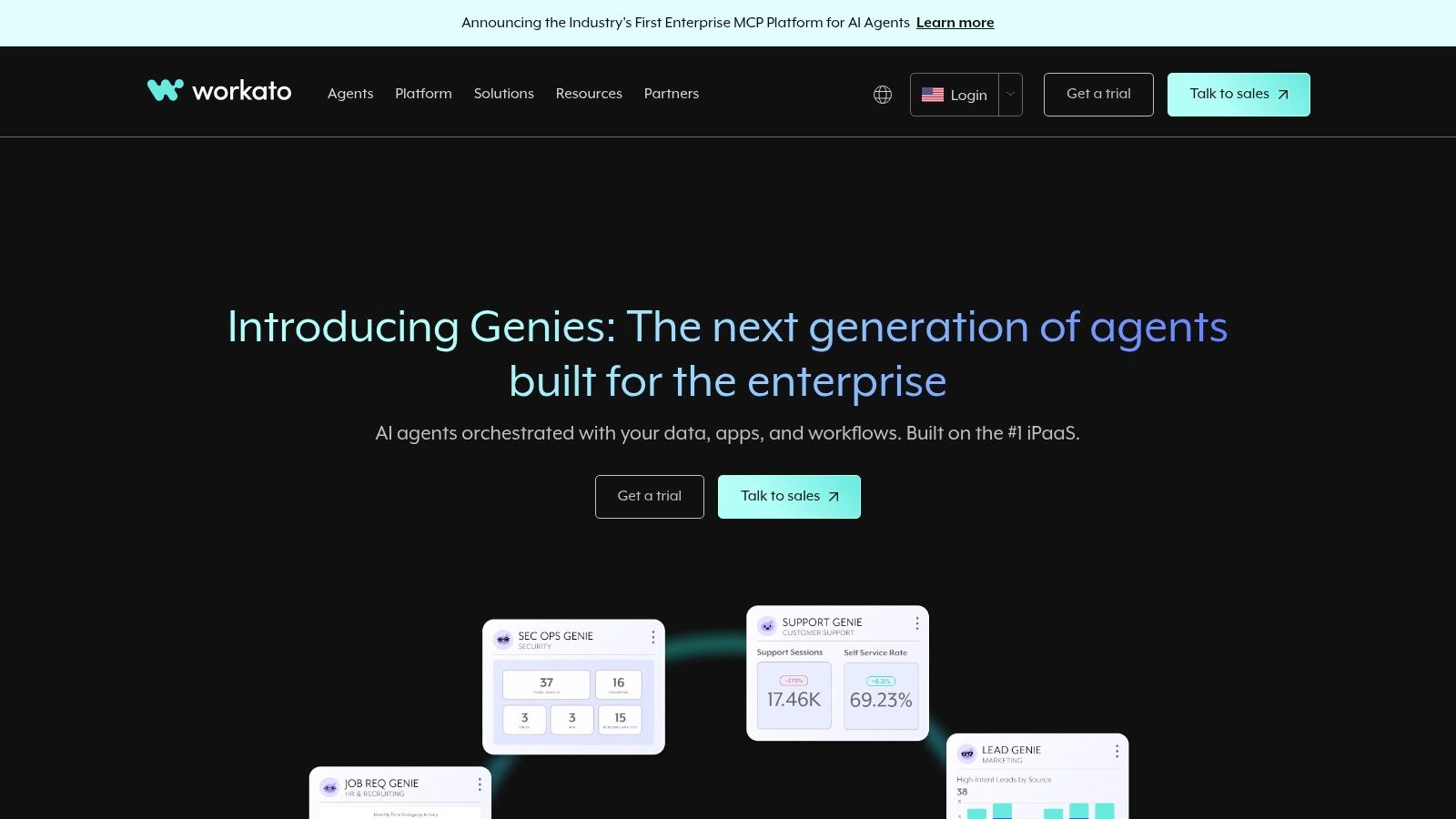
Unlike tools built for individual users, Workato is designed for collaborative, IT-governed automation. Its usage-based pricing is structured into different platform editions, which can be more predictable for large-scale deployments. For businesses where scalability and security are non-negotiable, Workato provides the necessary framework.
Key Details & Pricing
- Best For: Enterprise IT departments and business systems teams needing secure, scalable, and governable automations.
- Pricing: Custom pricing based on platform editions and usage. Prospective users must contact sales for a quote.
8. Tray.io
Tray.io positions itself as a low-code integration platform built for the modern enterprise. Its visual, drag-and-drop workflow builder is sophisticated enough for complex automations while remaining accessible to business technologists. The platform is designed to handle both internal process automation and embedded integration use cases.
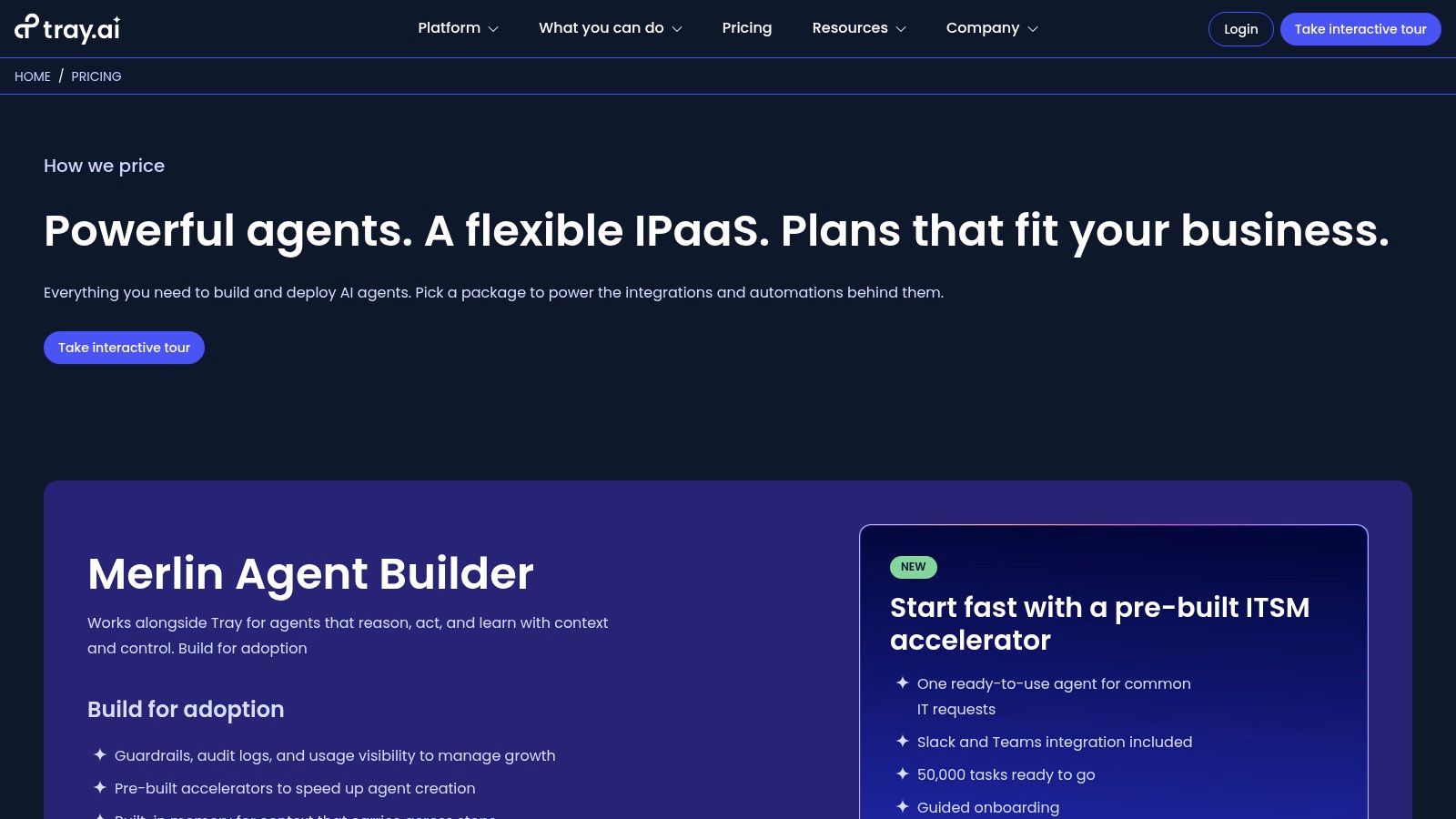
What sets Tray.io apart is its strong focus on enterprise-grade features, such as granular role-based access controls and audit logs. This allows IT departments to maintain control while empowering business units to build their own solutions. While its feature set is robust, pricing is not public and is geared toward larger teams.
Key Details & Pricing
- Best For: Enterprise teams, IT departments, and product managers who need a scalable and secure automation platform.
- Pricing: Custom pricing is available upon request. Plans are tailored to specific usage, support, and feature needs.
9. Integrately
Integrately positions itself as a user-friendly and cost-effective automation platform, making it a strong alternative for small businesses. Its main draw is a massive library of "1-click" automation templates that allow non-technical users to set up common workflows in seconds. This focus on simplicity and speed removes much of the initial setup friction.
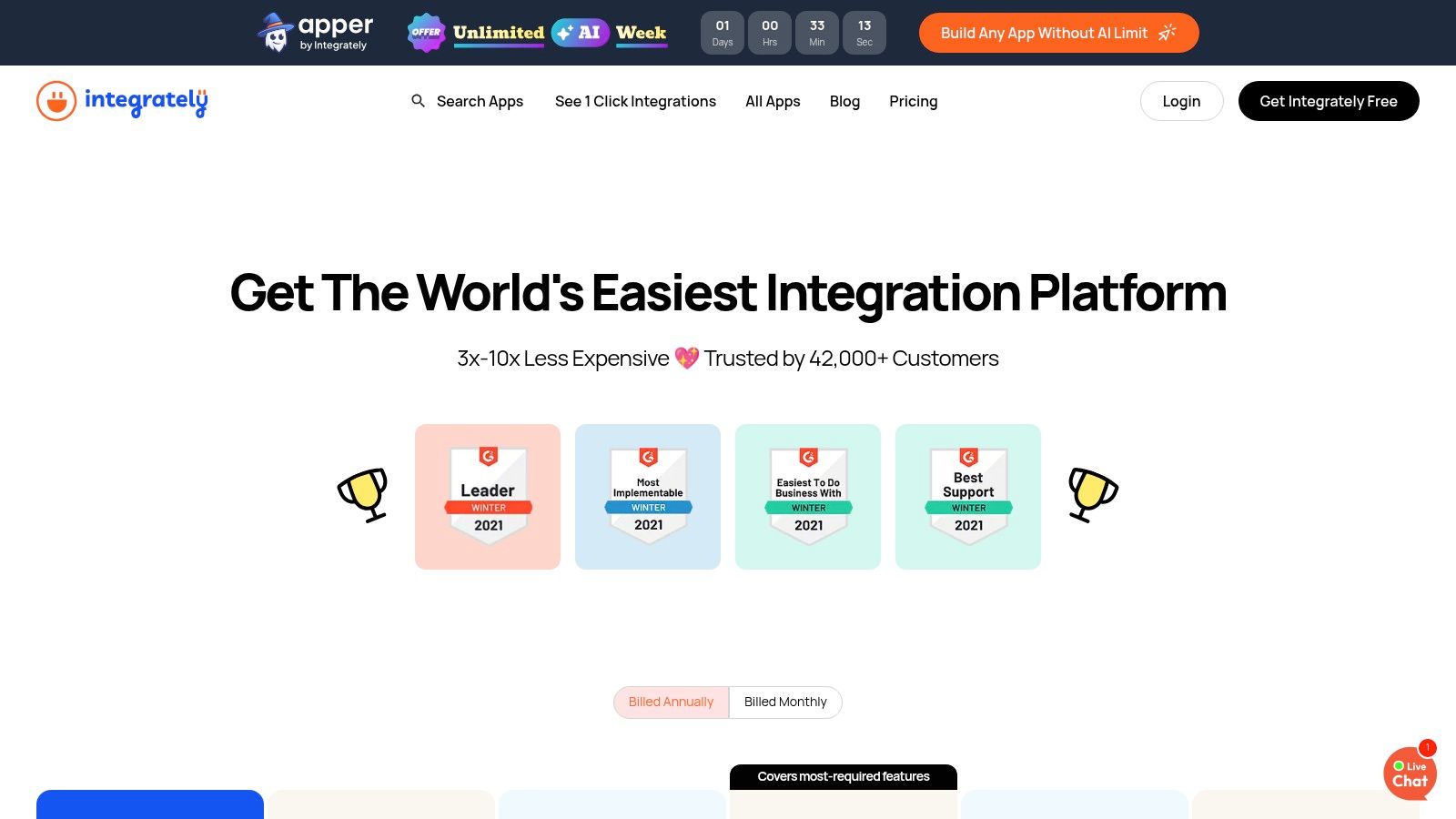
The platform's value proposition is centered on its generous task allowances. Integrately’s paid plans often provide a significantly higher number of tasks per dollar compared to many competitors. While its app library is smaller than industry giants, it covers the most popular business applications.
Key Details & Pricing
- Best For: Small business owners and marketing teams looking for a simple, budget-friendly automation tool.
- Pricing: Offers a free plan with 100 tasks/month. Paid plans start at $19.99 per month (billed annually).
10. Zoho Flow
For businesses deeply integrated into the Zoho ecosystem, Zoho Flow presents a compelling and native automation solution. It acts as the connective tissue between Zoho's suite of applications, such as Zoho CRM and Books, while also supporting over 600 third-party apps. This makes it an obvious choice for teams aiming to streamline processes within their primary software environment.
Zoho Flow is a logical choice for current Zoho users, offering seamless data transfer and process automation. Its pricing is structured around the number of tasks, with different tiers offering varying polling frequencies. While some of its connectors rely on polling, its deep integration capabilities within its own ecosystem are a significant advantage.
Key Details & Pricing
- Best For: Businesses already using the Zoho suite of applications who need to automate internal processes.
- Pricing: Offers a free plan with 100 tasks/month. Paid plans start at $10 per organization per month (billed monthly).
11. Pabbly Connect
Pabbly Connect positions itself as a strong alternative for users who prioritize budget and high task volume. It targets price-sensitive small to medium-sized businesses by offering plans that often include "unlimited" workflows and very generous task allowances. This straightforward approach makes it an appealing choice for teams that run numerous simple automations and want predictable, low-cost billing.
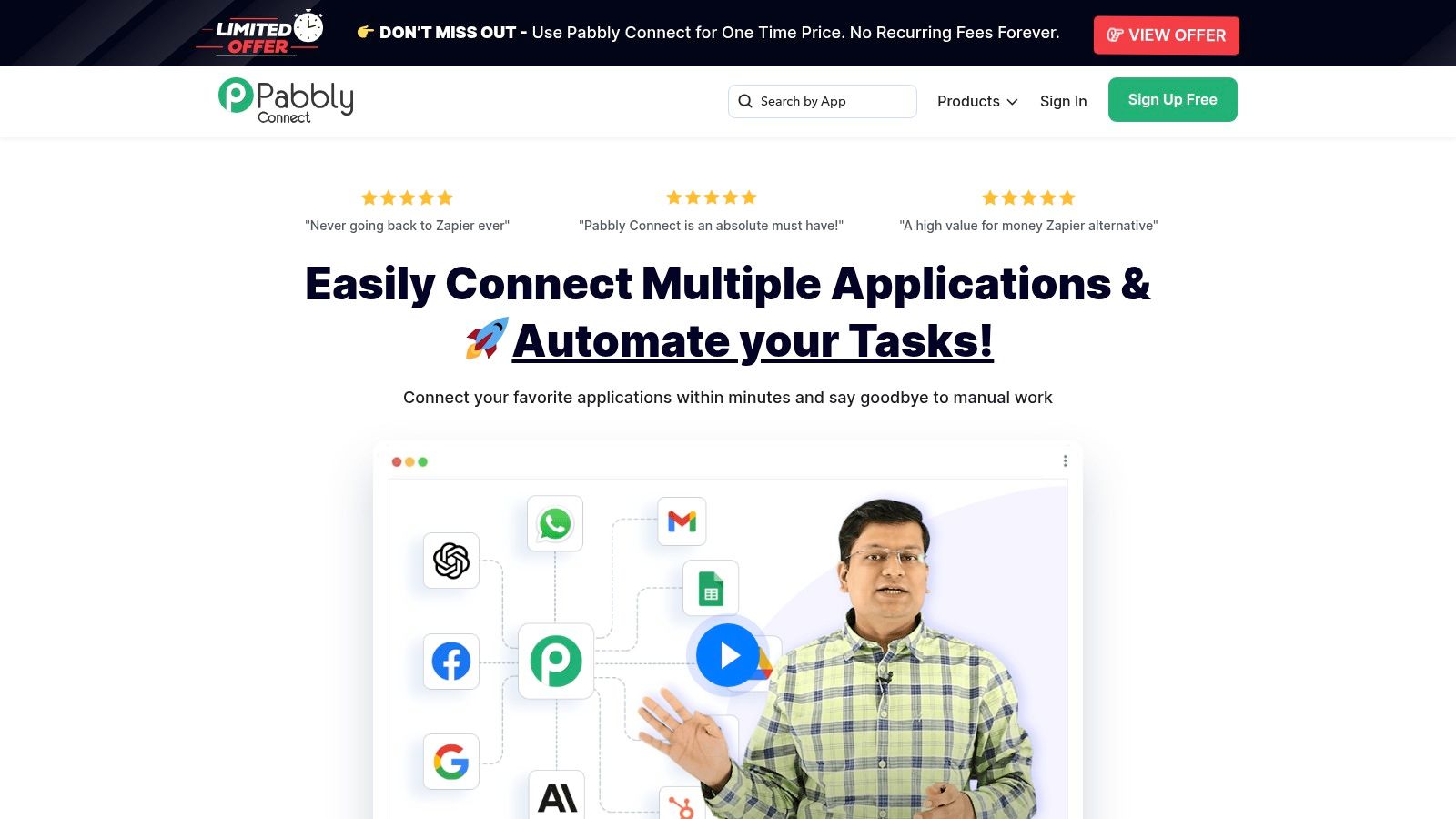
While its promotional lifetime deals can offer exceptional value, its app ecosystem is smaller than that of major competitors. The user interface is functional and provides a linear, step-by-step workflow builder. However, it lacks the advanced visual canvas and complex logic routing found in some other tools.
Key Details & Pricing
- Best For: Marketers and small businesses needing high-volume, cost-effective automations with predictable pricing.
- Pricing: Offers a free plan with 100 tasks/month. Paid plans start at $16 per month (billed annually).
12. G2
Instead of being a direct automation tool, G2 serves as an essential research hub for anyone evaluating the market of Zapier alternatives. It aggregates up-to-date rankings, user reviews, and feature comparisons for a wide range of iPaaS and AI automation platforms. This makes it an invaluable starting point for creating a shortlist of potential tools.

While not an automation platform itself, G2 streamlines the crucial discovery phase of adopting a new tool. It provides direct links to vendor websites, free trials, and demos, consolidating the research process. The platform is especially useful for side-by-side assessments and understanding nuanced pros and cons.
Key Details & Pricing
- Best For: Teams and decision-makers in the research and evaluation phase, seeking unbiased user feedback.
- Pricing: Free to use for research and reviews.
Visit G2
How do the best Zapier alternatives compare?
To help you choose, this table breaks down the key attributes of the top automation platforms. Each offers a different approach to building workflows, tailored to specific user needs and technical abilities.
PlatformCore StrengthIdeal UserPricing ModelCodeWordsAI-native chat builderFounders, operatorsUsage-basedMakeVisual canvas for complex logicPower users, SMBsOperations-basedn8nOpen-source & self-hostableDevelopers, technical teamsExecution-basedPipedreamDeveloper-centric, code stepsEngineers, API expertsCompute-basedMicrosoft Power AutomateDeep Microsoft 365 integrationEnterprises in MS ecosystemPer user/flowWorkatoEnterprise governance & securityLarge organizations, ITCustom/Quote
*Methodology Note: This comparison focuses on platforms offering distinct architectural or philosophical differences from Zapier's linear model, targeting users with moderate to advanced automation needs.*
What are the implications of choosing a new automation tool?
The journey through Zapier alternatives reveals a fundamental shift in how we approach automation. It's a move away from simply connecting two applications with a predefined trigger and action. Instead, it’s about architecting intelligent, multi-step systems that can adapt, reason, and execute complex business logic. The central metaphor threaded through this transition is the move from being a simple tool operator to becoming a true system architect.
Selecting the right tool isn't about finding a "better Zapier." It's about aligning a platform's core philosophy with your team's specific needs and technical comfort.
- For Visual Thinkers: Platforms like Make offer a powerful middle ground, retaining a visual interface but granting more control over multi-path logic.
- For Technical Teams: Pipedream and the open-source power of n8n provide ultimate flexibility, catering to users who are comfortable with code.
- For AI-Native Builders: Tools like CodeWords represent the next step, using natural language to define and build workflows, moving the bottleneck from UI navigation to clear problem articulation.
Whichever path you choose, adopting any of these Zapier alternatives hinges on a shift in mindset from single-task automation to proactive, system-level thinking. The ultimate goal is not to have a hundred disparate automations firing in the background. It is to build a coherent, resilient operational system for your business — one that adapts, learns, and frees up human creativity to focus on problems that truly matter. You are no longer just connecting apps; you are composing intelligent solutions.
Start automating now





